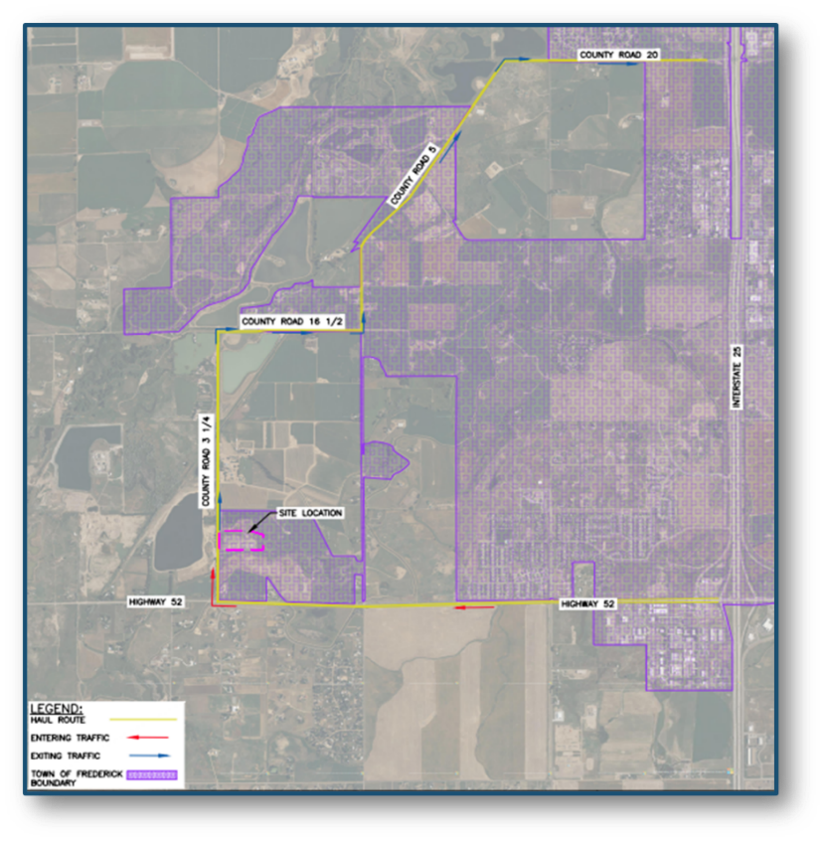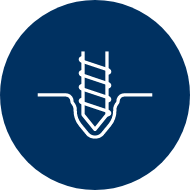File Pad (Frederick)
Overview & Location
The File 32H-K268 Pad is located in near the intersection of CR 3 ¼ and State Highway 52. The proposed expansion of the existing pad will occupy approximately 10 acres during pre-production (drilling and completions), scaling down to approximately five acres during production. The plan proposes six drilling spacing units and will include up to 28 new horizontal wells. A significant beneficial impact of this development is the plugging of 18 legacy (old/existing) wells and the reclamation of 8 existing locations.
Haul Route
Proposed Haul Route Directions
Civitas developed the proposed haul route to minimize the traffic in the area for our pre-production operations (construction, drilling, and completions). The route to and from I-25 primarily utilizes right hand turns to ease traffic concerns. We are also aware of increased traffic in the area during the fall season – during peak traffic during our pre-production operations, we expect about 65 trucks in the area over a 24-hour period. This means, during the day, we can estimate that only half that amount would contribute to increased traffic, an average of approximately two to three trucks per hour.
Entering the Well Pad:
- Travel westbound on Highway 52 to CR 3 1/4.
- Turn right (north) onto CR 3 1/4.
- Turn right onto the existing south access drive of the pad site.
Exiting the Well Pad:
- Use the existing south access drive.
- Turn right (north) onto CR 3 1/4.
- Turn right (east) onto CR 16 1/2.
- Turn left (north) onto CR 5.
- Continue east on County Road 20 to the I-25 Frontage Road intersections.
The yellow line on the map indicates this haul route.

Estimated Development Plan Timeline
Average Daily Truck Trips: 9
Average Daily Employee Trips: 5
Duration [Days]: 60
Operating Hours: Daylight Hours

Average Daily Truck Trips: 31
Average Daily Employee Trips: 18
Duration [Days]: 125
Operating Hours: 24 hrs/day

Average Daily Truck Trips: 67
Average Daily Employee Trips: 20
Duration [Days]: 125
Operating Hours: 24 hrs/day

Average Daily Truck Trips: 4
Average Daily Employee Trips: 0
Duration [Days]: 60
Operating Hours: Daylight Hours

Average Daily Truck Trips: 0
Average Daily Employee Trips: 0
Duration [Days]: On Going
Operating Hours: 24 hrs/day

Air Quality – Air Monitoring
Smart Engineering to Lessen Our Impact
- Electric drilling: We’ll use electric-powered rigs instead of diesel ones. This is like using an electric car instead of a gas-guzzler – it creates much less pollution.
- Cleaner, best-in-class engines: During completions, we'll use the cleanest available engines, tier IV, similar to the newest, most efficient truck engines.
- “Tankless Design”: Instead of traditional tanks that have a lot of emissions, this pad will use pressurized vessels and all produces gases and fluids will leave the pad via pipeline
- Using electricity: We're always looking for ways to switch from gas or diesel power to cleaner electricity wherever it makes sense. The pad will run on electricity for the life of the pad.
Checking for Leaks and Keeping the Air Clean
- Regular checks by sight, smell, and sound: During all phases of our work our teams regularly walk around and carefully look, smell, and listen for any signs of leaks from equipment that holds oil, gas, or chemicals.
- High-tech leak detection with special cameras: We have a strong program to find and fix leaks quickly. We use special cameras that can "see" gas leaks that we can’t. We start using these cameras during drilling and continue checking for leaks throughout the entire life of the site.
- Government approval for air monitoring: Our plan for monitoring air quality must be reviewed and approved by Colorado's main health and environmental agency, the CDPHE. This ensures our methods meet strict state standards for keeping the air clean.
Ground Water Protection
- Lining the Ground during drilling and construction: We put down a heavy-duty plastic sheet (a polyethylene liner, like a really thick tarp) on the ground. This stops any spills from soaking into the soil and reaching nearby water.
- Building a safety barrier around equipment: We build a containment system, like a big tray or berm, around all the production equipment. If anything leaks, it's caught in this barrier and can't escape into the environment.
- Having a spill prevention plan: We create a detailed plan specifically for each site that explains exactly how we'll prevent spills and what we'll do if one happens. It's like a rulebook for keeping things clean.
- Sound walls (32' high) will be constructed around the perimeter of the location
- Continuous noise monitoring terminals will be placed strategically between the pad and residential building units
- A "quiet completions fleet" will be used for hydraulic fracturing operations.
- Expanding existing facilities reduces the duration for potential noise impacts.
- Permanent production facility will be powered by grid power.
- Lighting will be angled downward to limit the halo effect off location & placed at reasonable heights to limit spillage off location.
- Sound walls (32' high) also minimize lighting impacts to surrounding receptors.
- No lighting will be present on the permanent production facility.
- Existing access road is oriented to reduce lighting impacts from vehicles on surrounding receptors.
Sealed Fluid Management:
We use a "closed-loop" system, meaning all drilling fluids are contained and recycled, eliminating open pits that can emit odors.
Odor-Conscious Materials:
We specifically choose Group III drilling fluids, known for their very low odor profile. We also remove drilling waste daily.
Modern Infrastructure
Our production facilities will be powered by clean, reliable grid electricity, avoiding smelly generators. We also utilize instrument air for pneumatic controls, which is cleaner than gas-powered alternatives. Maintenance is performed in a dedicated, pressurized vessel. The entire location will be designed without large storage tanks, further reducing potential odor sources.
